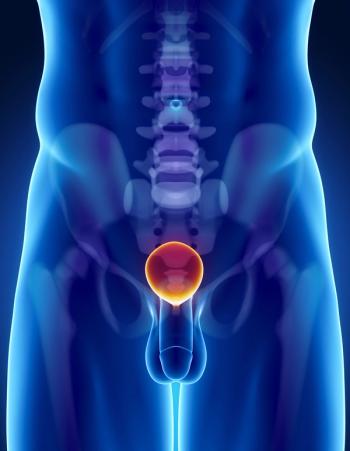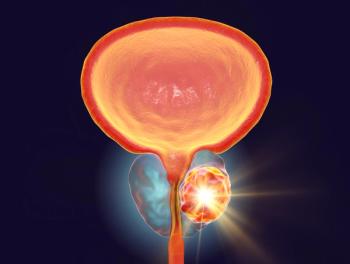
Oncology NEWS International
- Oncology NEWS International Vol 19 No 4
- Volume 19
- Issue 4
RTOG trial offers first evidence for benefit of hormone therapy + radiation in intermediate-risk prostate cancer
One of the largest clinical trials classifies which patients will benefit most from androgen deprivation therapy paired with radiotherapy.
ABSTRACT: One of the largest clinical trials classifies which patients will benefit most from androgen deprivation therapy paired with radiotherapy.
SAN FRANCISCO-Men with intermediate-risk prostate cancer who undergo short-term hormone therapy, given just before and during radiation treatment, saw prolonged survival and a reduced risk of recurrence, according to a phase III study presented at the 2010 Genitourinary Cancers Symposium. However, adding hormone treatment to radiation therapy in men with low-risk, early-stage disease does not appear to be advantageous.
The RTOG 94-08 trial was one of the largest clinical trials of prostate cancer ever completed. From October 1994 to April 2001, 1,979 patients with T1b to T2B adenocarcinoma of the prostate and a prostate-specific antigen (PSA) level of 20 or lower were randomized to receive either hormonal therapy two months prior to and two months during radiation therapy
(n = 987 patients) or radiation therapy alone (n = 992 patients).
"Scientific evidence now shows us when to deliver hormone therapy with radiation in patients with localized prostate cancer. Specifically, men with high-risk disease should receive long-term androgen deprivation therapy, those at intermediate risk should receive short-term androgen deprivation therapy, and those at low risk don't appear to need androgen deprivation therapy," said study coauthor Christopher U. Jones, MD, a radiation oncologist from Radiological Associates of Sacramento in California.
Men with low-risk disease make up the majority of prostate cancer patients. Being able to say with assurance that they do not need hormone therapy is extremely important, Dr. Jones said.
"There are consequences from short-term hormonal therapy. Men will experience hot flashes and impotence, and we don't know what the long-term effect on sexual function is when hormones are combined with radiation. So we need to know if there is a real benefit to an individual patient from adding hormones to radiation before adopting this as standard practice," he explained.
For this trial, hormonal therapy consisted of total androgen suppression with flutamide (Eulexin) at a dose of 150 mg orally three times a day with either monthly goserelin (Zoladex) 3.6 mg subcutaneously or leuprolide (Lupron) 7.5 mg intramuscularly.
Radiation therapy consisted of a dose of 66.6 Gy delivered to the prostate. "This dose and the techniques were consistent with the standard of care in 1994, which is when the study opened," Dr. Jones said.
Pretreatment characteristics were balanced between the two arms (see Table). The median follow-up of patients was 8.4 years in the hormone plus radiation therapy arm and 8.1 years in the radiation therapy alone arm (abstract 6).
The results showed that 51% of the patients who received hormonal therapy plus radiation were still alive at 12 years, compared with 46% of those who received radiation alone. During a symposium press briefing, Dr. Jones said that short-term hormonal therapy given prior to and during radiation treatment increased a man's chance of living at 10 years from 57% to 62%. Hormonal treatment also increased the 10-year disease-specific survival rate, from 92% to 96%.
Grade 3 or 4 liver toxicity occurred in less than 5% of patients, and liver toxicity was the most common hormonal toxicity. "The addition of hormones did not increase the risk of death from intercurrent disease, and no significant differences in early or late gastrointestinal or genitourinary toxicity were observed between the two treatment arms," he said.
©ASCO/Scott Morgan 2007
At two years following treatment, 843 men underwent repeat prostate biopsies. In those who were treated with hormones and radiation, 78% of the biopsies showed no cancer vs 60% in the radiation-only group. "We wanted to rebiopsy so that we could show that the hormones actually help radiation kill the cancer cells in the prostate," Dr. Jones said.
The survival benefit with hormonal therapy appeared to be greatest in men with a Gleason score of 7 or a Gleason score of
As for men with high-risk disease, Dr. Jones said that other studies have demonstrated that these men need to be treated with more than four months of androgen deprivation.
A new trial (RTOG 08-15) will study whether intermediate-risk patients will continue to derive benefit from the addition of short-term hormonal therapy to the current practice of delivering higher doses of radiation with advanced techniques, such as intensity-modulated radiation therapy (IMRT), image-guided radiation therapy (IGRT), and low dose rate or high dose rate brachytherapy.
"This is a very important paper. It is the first evidence we have for the benefit of radiation in intermediate-risk patients," commented Nicholas J. Vogelzang, MD, head of the section of genitourinary cancer at the Nevada Cancer Institute in Las Vegas. "There are still more data that need to be presented, but this is a major advance for those patients who are on the border of good and poor risk."
Articles in this issue
over 15 years ago
Thyroid Cancer: Shifts in Surgical Management and Follow-upover 15 years ago
High dietary polyamines may foster colorectal adenomasover 15 years ago
Duke doctor named new chair of NCCN board of directorsover 15 years ago
Study sheds light on lung cancer and African Americansover 15 years ago
Everolimus achieves ‘potent’ results in rare form of NHLover 15 years ago
Who's Newsover 15 years ago
Analgesic use may decrease postmenopausal estrogen levelsover 15 years ago
Healthcare legislation boosts future of cancer care servicesNewsletter
Stay up to date on recent advances in the multidisciplinary approach to cancer.































































































